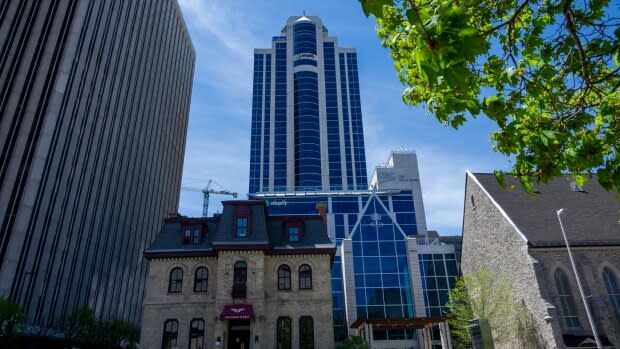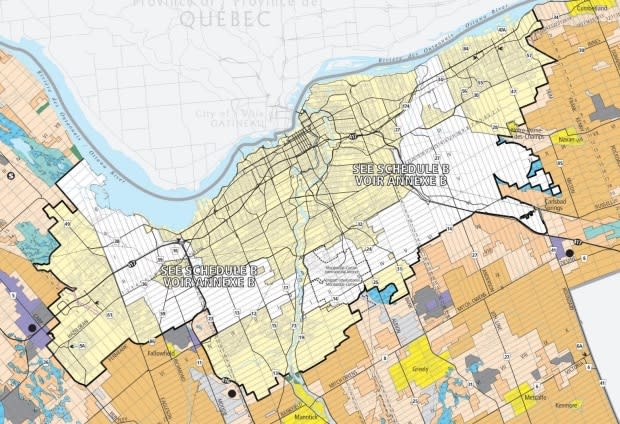Council approves major expansion of city's suburbs

Ottawa city council voted 15 to 6 Wednesday to expand the city's suburbs by hundreds of hectares, a decision that followed weeks of debate about how the city should grow over the next two decades.
Mayor Jim Watson has argued that "modestly" expanding the supply of residential land will help keep home prices lower, and give builders more time to adapt to the concept of denser development.
"Ottawa will have one of the most aggressive intensification targets in all of Canada," Watson said during Wednesday's meeting, which was held by teleconference.
"We've heard from the vast majority of residents that they support intensification, but they want it to be done thoughtfully through design, while respecting the characteristic of established communities."
"People have a right to pick the types of homes they want to live in," planning committee chair Jan Harder added. "Planning isn't about taking away that choice."
Three options were on the table, but council ultimately went with the advice of city staff, agreeing to add 1,281 hectares of rural land for future suburban development. Council put off a separate decision to add hectares for warehouses and industrial parks at highway interchanges.
The councillors who voted against the expansion, which could see 23,000 homes built in the newly added areas, were: Mathieu Fleury, Rawlson King, Jeff Leiper, Catherine McKenney, Shawn Menard and Theresa Kavanagh.
Councillors Diane Deans and Rick Chiarelli were absent.
Opponents to the expansion expressed concerns that the expansion will harm the environment, drive up the tax rate and threaten the financial viability of the city as taxpayers are left on the hook for the added infrastructure.
"The arguments being used around this table can be used forever until we have no urban boundary left in the city," said Menard, who's been a particularly vocal critic of expansion.
"This is a political choice we're making," he said. "We need to at some point make a political choice that this is going to stop, this is going to end."
400,000 new residents
The past few weeks have seen hours of debate and pressure from all sides as councillors moved closer to their decision about how to house 400,000 more residents by 2046, and how to achieve the right balance between urban infill and suburban growth.
Staff called for 51 per cent growth through intensification and the rest through new subdivisions, requiring extra land beyond what's already in the pipeline.
Planning chief Steve Willis said staff gave its "best package" after balancing competing policy goals such as reducing greenhouse gases and keeping the housing market open to new buyers.

Attempts to restrict growth fall flat
At council, Coun. Riley Brockington moved a motion to freeze the urban boundary. "The people of Ottawa want this option to be debated today," he said.
An EKOS poll commissioned by three urban councillors indicated more than half of respondents wanted council to hold the line, and worried expanding the urban boundary would place a burden on city services and jeopardize its climate change goals.
"Our beautiful city needs an absolute rethink on how it's built, how it's designed and how our mature neighbourhoods evolve," Brockington said.
But Watson said staff had been clear that holding the line risked failing to meet provincial rules guarding the long-term supply of land for future housing.
When Brockingon's motion failed in a 13-8 vote, the River ward councillor moved another motion to grow the urban area by less than what staff had suggested, which he called "a compromise that is doable." That also failed.
Concern about teleworking
At the request of Menard, city staff will be holding off on adding anywhere from 69 to 369 hectares of expansion lands for industrial parks and warehouses at highway interchanges until they've completed more study.

Councillors also appeared concerned about the impact of the growing trend of working from home, especially after local e-commerce powerhouse Shopify announced its plans to allow many employees to work remotely permanently.
Coun. Keith Egli moved a motion, seconded by the mayor, to watch whether office vacancies in the city increase, and if they do, whether that commercial space can be repurposed for homes.
Next steps
Council approved the expansion without knowing exactly where the new land is located. Now that the expansion is approved, staff will score each parcel against criteria that council also approved Wednesday.
A separate motion to take major agricultural resource areas off the table gained unanimous support, and was enhanced to include a provision that all new infrastructure related to the expanded areas, such as storm water ponds, be self-contained and not spill over into adjacent rural properties.

The city growth strategy also excludes wetlands, flood plains and other protected natural areas.
Properties near rapid transit, or even future rapid transit, will score additional points, as will properties within 1.9 kilomtres of park-and-ride stations, thanks to a successful motion from Coun. Allan Hubley.
The list of potential lands to be added to the urban area is expected to be brought back to council in the fall. The updated official plan, which is a highly detailed planning blueprint for the city, is expected later in 2021.


